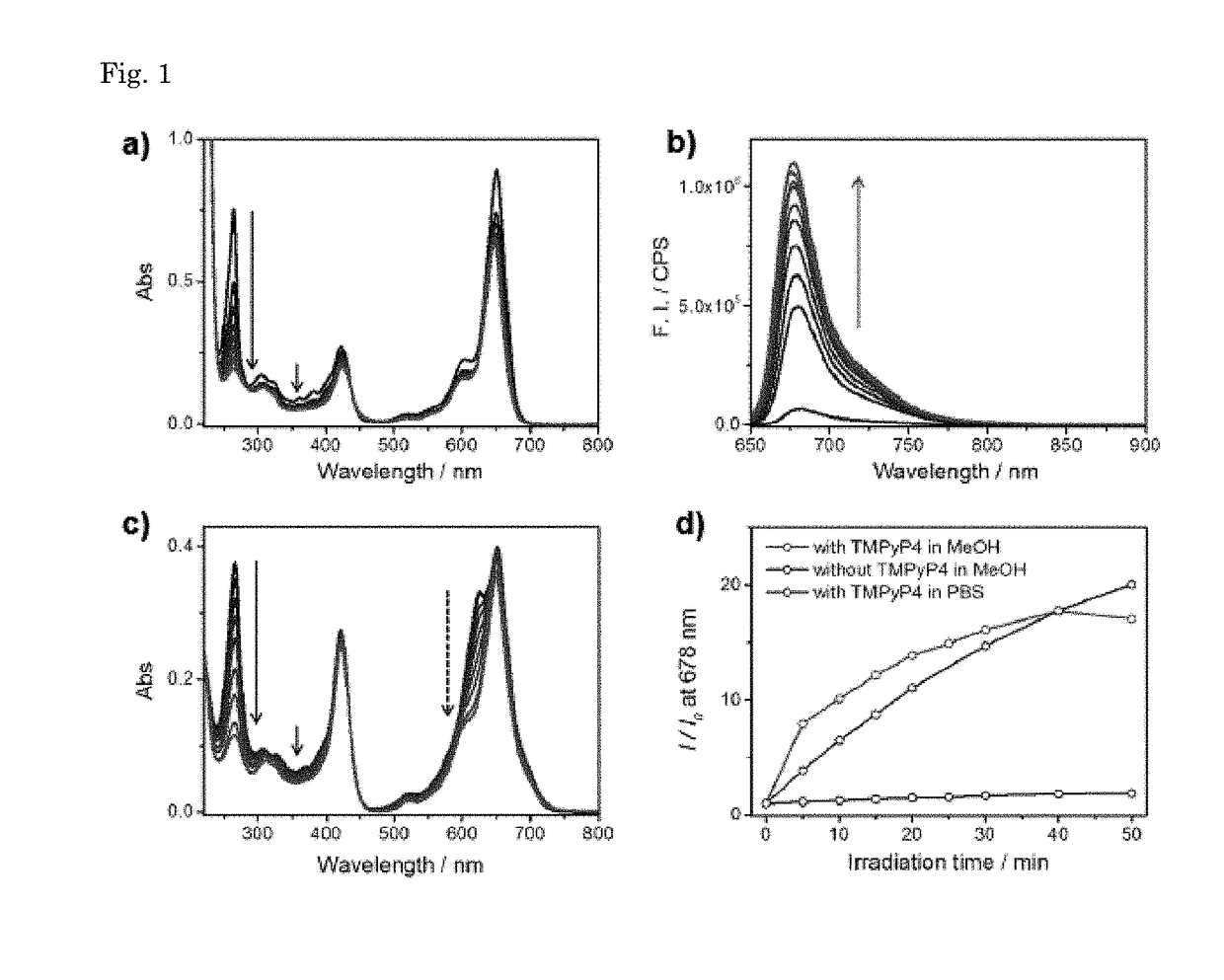Fluorescent Probe, Singlet Oxygen Detection Agent, and Singlet Oxygen Detection Method
a fluorescence probe and oxygen detection technology, applied in the field of fluorescence probes, can solve the problems of unrealistic methods and singlet oxygen attracted attention, and achieve the effects of suppressing the luminescence of the fluorescent probe of the present invention, increasing the fluorescence intensity, and increasing the intensity of luminescen
- Summary
- Abstract
- Description
- Claims
- Application Information
AI Technical Summary
Benefits of technology
Problems solved by technology
Method used
Image
Examples
example 1
nt Probe of the Present Invention (Si-DMA)
[0160]According to the method disclosed in Lukinavicios, G. et al., Nat. Chem., 5, 132-139 (2013), and Nagano T. et al., ACS Chem. Biol. 6, 600-608 (2011), silicon-xanthone (Si-xanthone) was synthesized using the synthesis route shown above.
2-Bromo-9,10-Dimethyl Anthracene (4)
[0161]
[0162]According to the method disclosed in Keana, J. F. W. et al., J. Org. Chem., 51, 3456-3462 (1986), 2-bromo-9,10-dimethyl anthracene (4) was synthesized using the synthesis route shown above.
[0163]Si-DMA
[0164]A dried flask was washed with argon, and 2-bromo-9,10-dimethyl anthracene (4) (0.85 mmol, 250 mg) and anhydrous THF (8.5 mL) were added to obtain a solution. The solution was cooled to −78° C., and sec-butyllithium (1.4 M cyclohexane solution, 0.61 mL, 0.85 mmol) was added, followed by stirring for 30 minutes.
[0165]Silicon-xanthone (Si-xanthone) (17.0 mg, 0.052 mmol) was dissolved in anhydrous THEF (8.5 mL) at the same temperature, a...
experiment 1
Spectrum and Luminescence Spectrum
[0170]FIG. 1 shows temporal change in fluorescence spectrum and luminescence spectrum of Si-DMA of Example 1 incubated with TMPyP4. The concentration of Si-DMA was 50 M, and the concentration of TMPyP4 was 5 M. The light irradiation was performed using a 510- to 550-nm wavelength ray at an intensity of 0.07 W / cm2 under magnetic stirring so as to generate singlet oxygen.
[0171]In FIGS. 1a) and 1c), the black arrows denote changes in absorption by peroxidation (solid line) of the anthracene structure and disaggregation of hydrogen aggregate (broken line). Further, in FIG. 1b), the red arrow shows an increase in fluorescence during 50-minute light irradiation. Conversely, FIG. 1d) shows that the fluorescence of Si-DMA did not increase even by light irradiation in the absence of TMPyP4, and that the fluorescence of Si-DMA increased during 50-minute light irradiation in the presence of TMPyP4 both in the methanol solution and the PBS solution. More specif...
experiment 2
Test
[0176]A test was performed to confirm whether Si-DMA of Example 1 causes no self-oxidation of dye and is selectively responsive to singlet oxygen.
[0177]First, an increase in fluorescence in proportion to the concentration of singlet oxygen generated by NaClO and H2O2 was observed both in an S-DMA monomer and an Si-DMA aggregate. FIG. 5 shows the results. In FIG. 5, the upper data shows the results of the S-DMA monomer, and the lower data shows the results of the Si-DMA aggregate. The measurement was performed by generating singlet oxygen using NaClO and H2O2 in a solution containing DMSO:methanol:tris buffer agent=1:49:50 (Si-DMA concentration=5 μM).
[0178]However, formation of aggregates decreases the effective concentration of the dye, thereby decreasing the reaction speed of Si-DMA. Therefore, a 5-μM Si-DMA solution was first prepared using a mixed solvent containing methanol and a pH 7.4 PBS buffer solution mixed at 1:1. In this solution, Si-DMA was present as a monomer. Subs...
PUM
| Property | Measurement | Unit |
|---|---|---|
| temperature | aaaaa | aaaaa |
| temperature | aaaaa | aaaaa |
| reaction time | aaaaa | aaaaa |
Abstract
Description
Claims
Application Information
 Login to View More
Login to View More - R&D
- Intellectual Property
- Life Sciences
- Materials
- Tech Scout
- Unparalleled Data Quality
- Higher Quality Content
- 60% Fewer Hallucinations
Browse by: Latest US Patents, China's latest patents, Technical Efficacy Thesaurus, Application Domain, Technology Topic, Popular Technical Reports.
© 2025 PatSnap. All rights reserved.Legal|Privacy policy|Modern Slavery Act Transparency Statement|Sitemap|About US| Contact US: help@patsnap.com



